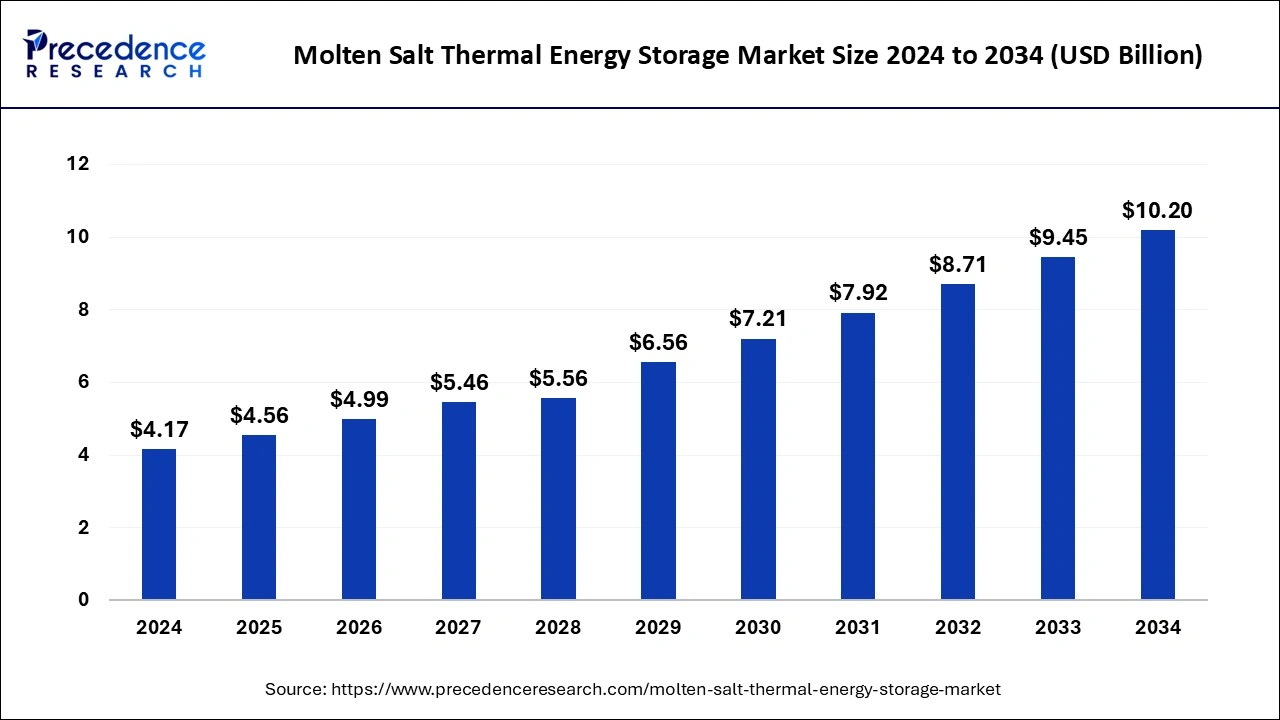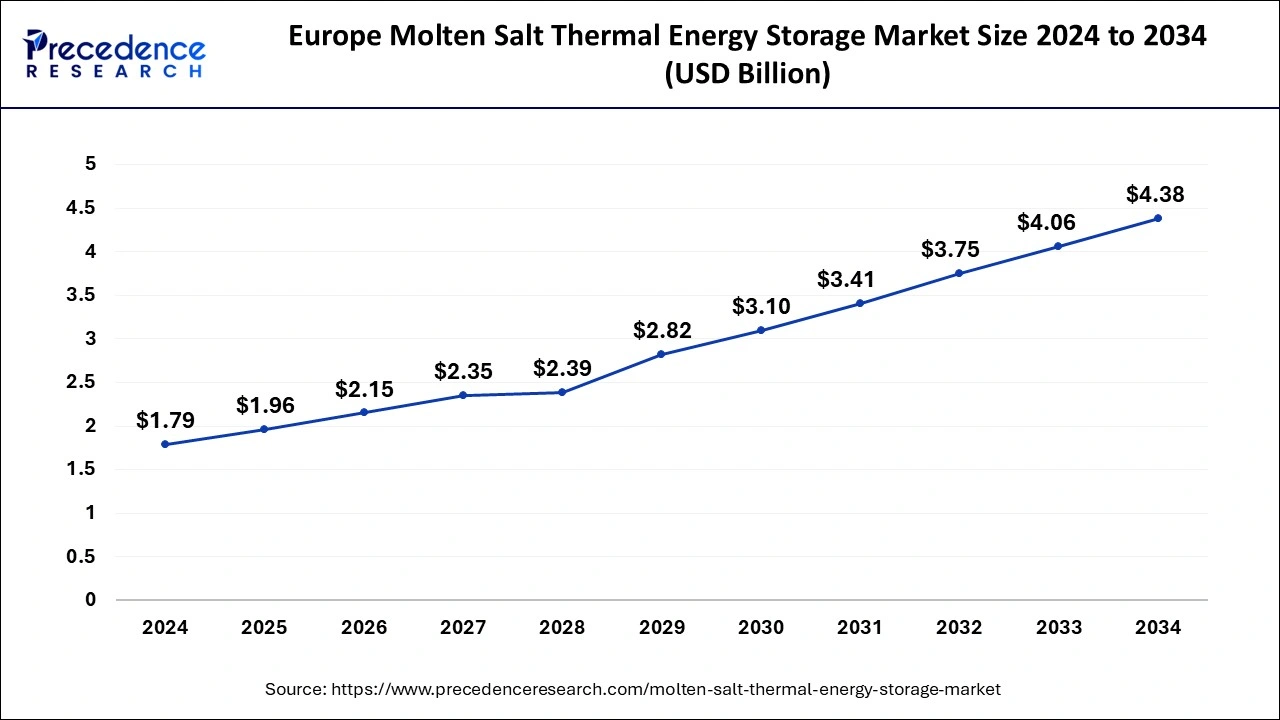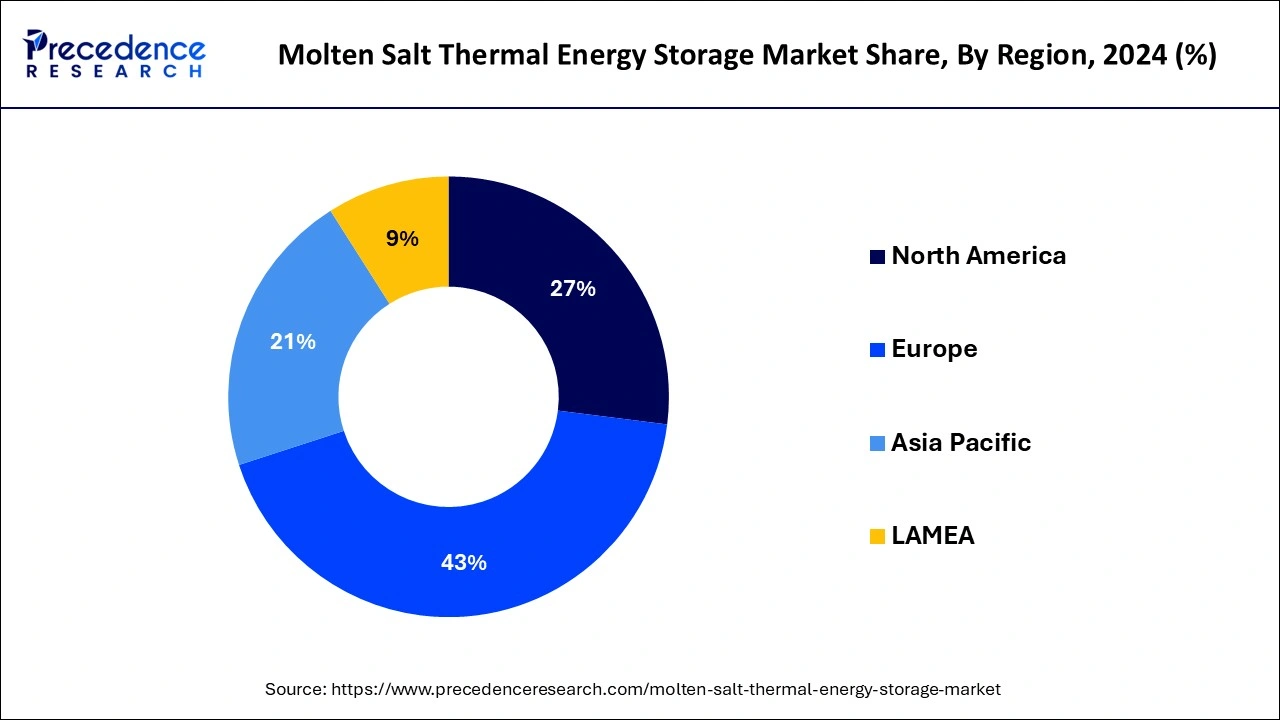September 2024
The global molten salt thermal energy storage market size is estimated at USD 4.56 billion in 2025 and is predicted to reach around USD 10.20 billion by 2034, accelerating at a CAGR of 9.35% from 2025 to 2034. The Europe molten salt thermal energy storage market size surpassed USD 1.96 billion in 2025 and is expanding at a CAGR of 9.36% during the forecast period. The market sizing and forecasts are revenue-based (USD Million/Billion), with 2024 as the base year.
The global molten salt thermal energy storage market size was estimated for USD 4.17 billion in 2024 and is anticipated to reach around USD 10.20 billion by 2034, growing at a CAGR of 9.35% from 2025 to 2034. The increasing adoption of renewable energy sources, the surge in electricity consumption, the rise in cost savings from energy storage systems, and rising government efforts to promote cleaner fuel are anticipated to propel the growth of the molten salt thermal energy storage market during the forecast period.

The integration of artificial intelligence (AI) in molten salt thermal energy storage market holds great potential in ushering in a groundbreaking era of innovation and efficiency in the power sector. AI is widely used in thermal energy storage systems to improve their efficiency, sustainability, and reliability. AI's integration has unlocked unprecedented capabilities, allowing for predicting energy demand, real-time monitoring, optimizing charging and discharging, reducing operational costs, and maximizing renewable energy use.
Several artificial intelligence (AI) techniques, such as artificial neural networks, particle swarm optimization, adaptive neuro-fuzzy inference systems, and support vector machines, have been widely explored in the field of energy storage. Therefore, AI integration has shown notable success as a crucial tool for governing, predicting, and optimizing thermal energy storage (TES) systems.
The Europe molten salt thermal energy storage market size was estimated at USD 1.79 billion in 2024 and is anticipated to be surpass around USD 4.39 billion by 2034, rising at a CAGR of 9.36% from 2025 to 2034.

Europe dominated the global molten salt thermal energy storage market with largest market share of 43% in 2024, and is anticipated to do so again in the years to come. Large nations can effectively utilize solar energy projects in the region because it is located below the Tropic of Capricorn. With a 9-hour capacity for molten salt, Gujarat Solar One is the biggest parabolic trough in all of India. A two-tank indirect thermal storage method is employed. During the predicted period, molten salt storage is anticipated to be extended and constructed. One of the biggest users of the molten salt energy storage method worldwide is China. China had a share of more than half of the brand-new CSP projects around the globe in 2019 and increased its domestic capacity for power production by 200 MW. Therefore, due to a rise in power consumption and investments from both government and private players, molten salt thermal energy storage is anticipated to develop at the quickest rate in the Asia region throughout the projection period.

Europe accounted for a sizable portion. Due to strict government rules governing emission standards and the utilization of renewable energy sources, the molten salt thermal energy storage business in the area was launched early. The market for molten salt thermal energy storage at the time was dominated by North America, with the other regions scarcely having a presence. The majority of European nations view the storage of thermal energy in molten salt as an efficient way to increase power production and delivery. The area has an advantage in terms of the most recent innovations and important player representation due to the great significance given to technology by the region. Molten salt thermal energy storage is anticipated to be used in large-capacity energy storage facilities for thermonuclear and latent heat in Europe in the near future.
It is promoted as a trustworthy option that may be included in a variety of applications, such as maintaining a secure power supply in various end-use sectors. Companies in the molten salt thermal energy storage business are seizing this chance to diversify their offerings since the energy sector is always working to lower its high CO2 emissions. Molten salt thermal energy storage is being used to stabilize the grid since renewable energies, such as wind and solar power, are associated with volatility in the supply of electricity.
Companies in the worldwide molten salt thermal energy storage market are analyzing micro- and macroeconomic factors to maintain company continuity in the face of the current coronavirus outbreak. Molten salts has a significant part in the optimization of energy in industrial operations.
Despite growing in popularity as a useful thermal energy storage alternative, molten salts tend to harden in pipes in the non-presence of heat due to their relatively high melting point. Because of this, market players s in the worldwide molten salt thermal energy storage market are starting to realize how crucial it is to implement an anti-freeze system. Molten salt nano-composites which are based on nanodiamonds offer fascinating potentials as fluids for heat transfer and thermal energy storage medium. They are innovative and economically advantageous. The development of the worldwide molten salt thermal energy storage market depends on the solar energy sector's growth. As the energy segment welcomes a variety of usage, new prospects for the generation of renewable energy have developed. The energy industry wants to provide more infrastructure for the production of renewable energy. The energy produced by these subsidiary platforms may be used by offshore wind farms, big solar facilities, and biofuel production facilities.
| Report Coverage | Details |
| Market Size in 2025 | USD 4.56 Billion |
| Market Size by 2034 | USD 10.20 Billion |
| Growth Rate from 2025 to 2034 | CAGR of 9.35% |
| Largest Market | Europe |
| Base Year | 2024 |
| Forecast Period | 2025 to 2034 |
| Segments Covered | By Technology, Regions |
| Regions Covered | North America, Europe, Asia-Pacific, Latin America, and Middle East & Africa |
Increasing demand for new sources of renewable energy
Service providers reducing carbon emissions to transform the energy sector
High cost
Development of power transmission systems
Anti-freeze system installation may be able to prevent the solidification of molten salts.
The parabolic trough, which competes with solar power tower technology, is one of the most effective methods for molten salt storage. 2019 has already seen the installation of several different parabolic trough molten solar energy storage systems throughout the world. Solar concentrating structures that use the shape of parabolic collectors are constructed of reflective materials. The salt melts as a result of the collectors' reflection of the solar energy that strikes it. The market is predicted to grow as a result of the push needed to lower the price of the energy produced from molten salt, which may be provided by various types of reflecting material and molten salt. In China's Gansu Province, a parabolic trough molten salt solar project is being built with an expected 100 megawatts of electricity production (MW). It can sustain electricity for seven hours without a source because to its molten salt storage system. With several concentrated solar power plants spread out across the nation and major solar industry players like Abengoa SA, Acciona, and, SA, Spain led the molten salt trough parabolic trough market in 2019. Therefore, it is anticipated that molten salt thermal energy storage with parabolic troughs would expand throughout the projected period due to the rise in power demand and the rising efficacy of molten salts and reflecting materials.
By Technology
By Geography
For inquiries regarding discounts, bulk purchases, or customization requests, please contact us at sales@precedenceresearch.com
No cookie-cutter, only authentic analysis – take the 1st step to become a Precedence Research client
September 2024
January 2025
October 2024
January 2025